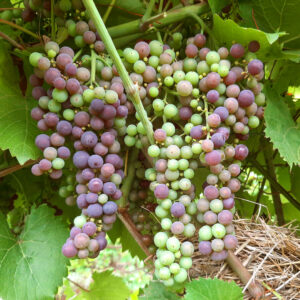Veraison is a major annual milestone in the grape ripening process.
The most obvious manifestation of veraison is that the grapes themselves begin to change color. Purple grapes change from a milky-green to purple whereas white grapes change from a milky-green to an amber-green with a measure of translucense.
From the standpoint of winemaking, the more important changes taking place at veraison are those taking place inside the grape. The grape is not initially very juicy but now it is softening and continuing to expand. What little juice that exists up until this point is very high in acid with virtually no sugar. From now until harvest, acidity will decrease and sugar will increase. We’d like to see the Marquette at about 24° Brix or 24% sugar at the time of harvest. Assuming that we can convert all of the sugar to alcohol during fermentation, that would give us a wine at 13.2% alcohol.

Also, flavors in the grape also develop during ripening. Interestingly, both the flavors we associate with wine and the color is, in most grape varieties, all in the skin and not in the pulp of the grape. The sugar and acid are in the pulp, however.
Finally, the size of the grape itself will continue to increase. In small, tight bunches like those on Foch grapevines, the grapes grow to fill in the spaces between the individual grapes in the bunch. If we have much rain, we can have fungus pressure because of lack of air circulation through the tight bunches. In loose bunches like Edelweiss, there is more space for air circulation and this variety is not as likely to have fungus damage.
The photo here was taken on Monday, July 25, in the Marquette vineyard at Meadowcreek by Adam Nunnikhoven. You can see the individual grapes at various stages of ripening. Normally, veraison occurs about July 15 or about ten days earlier. We are guessing about why it is later this year, but we think it is because we did some leaf removal and hedging in the Marquette this year. This may delay the harvest date which is usually in early September but expected heat may just accelerate ripening and fruit development so that we harvest at about the same time as in years past. We’ll have to wait to find out!
